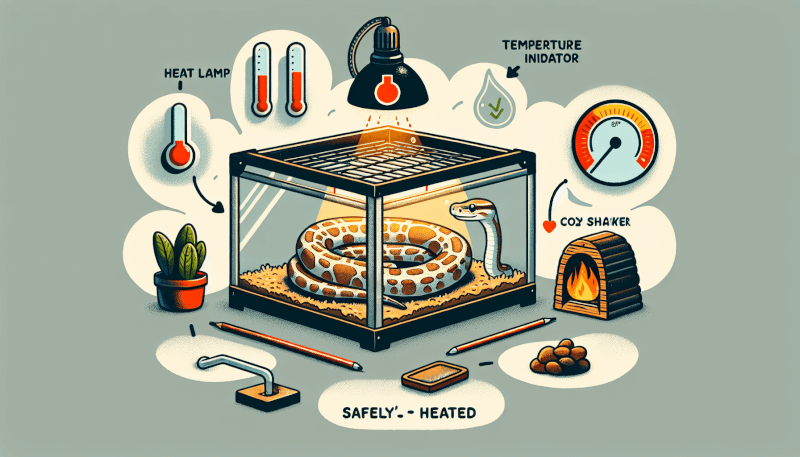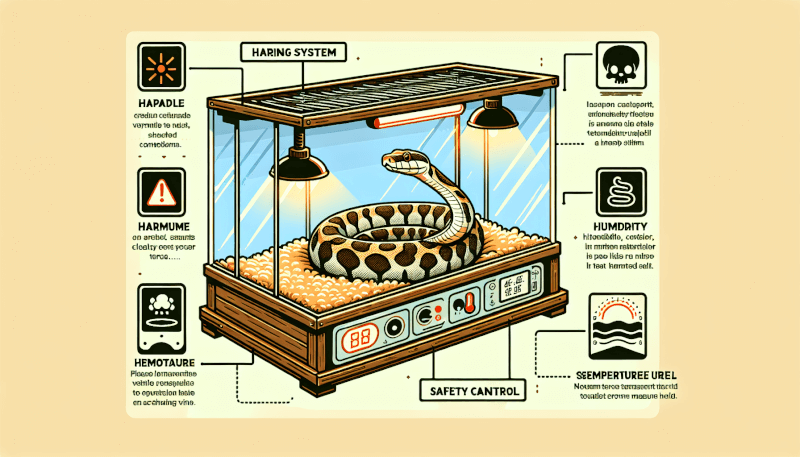In this article, you will learn about the importance of ensuring proper secure heating for your snake’s environment. Creating the right temperature and humidity levels in your snake’s habitat is crucial for their overall health and well-being. From understanding the specific heating requirements of different snake species to the various heating options available, this article will provide you with all the necessary information to keep your slithery companion comfortable and thriving. So, let’s dive in and explore the world of snake heating!
Choosing the Right Heating Equipment
When it comes to ensuring the comfort and well-being of your snake, choosing the right heating equipment is crucial. You want to create an environment that mimics their natural habitat, as well as provide them with the appropriate temperature range. By doing so, you can help your snake thrive in its enclosure.
Consider the snake’s natural habitat
Before selecting heating equipment, it’s important to consider your snake’s natural habitat. Different snake species come from various regions with distinct climates. Researching their native environment can give you valuable insight into the temperature range and heating needs of your snake. For example, if your snake is native to a tropical climate, it will require warmer temperatures compared to a snake from a more temperate region.
Determine the appropriate temperature range
Once you have a good understanding of your snake’s natural habitat, you can determine the appropriate temperature range for its enclosure. Snakes are ectothermic, meaning they rely on external heat sources to regulate their body temperature. Your snake’s enclosure should have a temperature gradient, allowing it to thermoregulate by moving to different areas with varying temperatures. Typically, a gradient ranging from 75-85°F (24-29°C) is suitable for most snake species.
Research different heating options
There are several heating options available for snake enclosures, and it’s important to research and choose the one that best suits your snake’s needs. The most common types of heat sources include heat pads, heat lamps, ceramic heat emitters, and radiant heat panels. Each has its unique advantages and disadvantages, so consider factors such as heat output, energy efficiency, and safety. It’s always a good idea to consult with experts or experienced snake owners to get recommendations based on their experience.
Heat Source Placement
The placement of your heating equipment within the enclosure plays a significant role in creating the ideal environment for your snake. It’s essential to ensure that the heat source is positioned correctly to provide the necessary warmth while avoiding any direct contact that could harm your snake.
Place the heating equipment on one side of the enclosure
To create a temperature gradient, it is advisable to place the heating equipment on one side of the enclosure. This allows your snake to choose between warmer and cooler areas as required. By providing this variety, you’re enabling your snake to fulfill its natural behavior of thermoregulation.
Ensure the heat source does not directly touch the snake or its habitat
While it may be tempting to position the heat source close to your snake for maximum warmth, it is crucial to make sure it does not directly touch the snake or its habitat. This can lead to burns or other health issues. Instead, create a safe distance between the heat source and your snake, allowing the heat to radiate and warm the enclosure naturally.
Monitoring Temperature
Maintaining a suitable temperature range in your snake’s enclosure is crucial for its overall health and well-being. To achieve this, you need to regularly monitor and record temperatures, ensuring they remain within the appropriate range and that there are no sudden fluctuations.
Use a reliable thermometer
Investing in a reliable thermometer will help you accurately measure and monitor the temperature in your snake’s enclosure. There are various options available, such as digital or analog thermometers, infrared temperature guns, or temperature probes. Choose one that suits your preference and provides accurate readings.
Regularly check and record temperatures
To ensure the temperature range remains consistent, it is important to regularly check and record temperatures at different spots within the enclosure. This will help you identify any potential issues or areas that may need adjustments. Keep a log of these readings to track any patterns or changes over time.
Monitor temperature fluctuations
Temperature fluctuations can occur due to various factors, such as changes in room temperature or malfunctioning heating equipment. It’s essential to be vigilant and monitor for any sudden or significant temperature changes. Regularly observing the temperature in the enclosure will allow you to identify and address these fluctuations promptly.
Heat Source Types
When selecting heating equipment, it’s crucial to understand the different types available and their specific advantages and disadvantages. Here are some common heat source options for snake enclosures:
Heat pads
Heat pads, also known as under-tank heaters, are designed to adhere to the underside of the enclosure. They provide a localized heat source and are commonly used to create a warm area for snakes to digest their food.
Heat lamps
Heat lamps, or basking bulbs, emit heat and light, simulating the sun’s warmth. They are often used to create a basking spot, where snakes can thermoregulate by positioning themselves closer or farther away from the heat source.
Ceramic heat emitters
Ceramic heat emitters are heat sources that emit infrared heat without visible light. They do not disturb the natural lighting cycle and are suitable for use during the day or night. Ceramic heat emitters can be used to provide an ambient heat source to maintain a consistent temperature gradient.
Radiant heat panels
Radiant heat panels are installed on the ceiling or side of the enclosure to radiate heat evenly throughout the space. They offer a gentle and consistent heat source, allowing for a stable temperature gradient within the enclosure.
Regulating Heat Distribution
Apart from selecting the appropriate heat source, it’s important to regulate heat distribution within the enclosure. Creating temperature gradients and providing hiding spots and elevated areas can help your snake feel secure and ensure it has options for thermoregulation.
Use thermostats or rheostats
To accurately regulate the temperature within the enclosure, consider using thermostats or rheostats. These devices allow you to control the output of the heat source and maintain a stable temperature. Some advanced models even offer programmable settings, ensuring consistency throughout the day.
Create temperature gradients
Snakes require different temperature zones within their enclosure to fulfill their thermoregulation needs. By creating a temperature gradient, you provide your snake with options to move between warmer and cooler areas as required. This will enable them to find their optimal comfort zone.
Provide hiding spots and elevated areas
Including hiding spots and elevated areas in the enclosure is essential. Snakes need secure hiding spots to feel safe and reduce stress. Elevated areas, such as branches or platforms, allow your snake to position itself at different heights, thereby accessing different temperature levels within the enclosure.
Backup Heating Options
It’s always wise to have backup heating options in case of power outages or equipment malfunctions. These contingencies can help ensure your snake’s environment remains within the appropriate temperature range, even during unexpected situations.
Consider a secondary heat source
Having a secondary heat source, such as a battery-powered heat pad or a portable heat lamp, can be extremely beneficial during power outages. These backup options can provide temporary warmth until regular power is restored.
Use heat packs during power outages
Heat packs, specifically designed for reptiles, can be utilized during power outages to provide a temporary heat source for your snake. These packs, activated by shaking or squeezing, emit gentle heat and can be placed in the enclosure, wrapped in a towel or blanket to prevent direct contact.
Safety Measures
Ensuring the safety of your snake is of utmost importance when it comes to heating equipment. Taking necessary safety precautions will help prevent accidents and potential harm to your snake.
Ensure the heating equipment is secure and cannot harm the snake
Make sure to securely fasten the heating equipment within the enclosure, ensuring it does not pose a risk to your snake. Loose or unstable equipment can become dangerous if knocked over or if the snake accidentally comes into contact with it.
Regularly inspect the equipment for any malfunctions or damage
Inspecting the heating equipment regularly is crucial to catch any potential malfunctions or damage. Check for frayed wires, loose connections, or any signs of wear and tear. Address any issues promptly by repairing or replacing the equipment. Regular maintenance will help prevent any accidents that could harm your snake.
Place a heat guard or barrier around heat sources
To further ensure the safety of your snake, consider placing a heat guard or barrier around the heat source. These guards act as a protective barrier, preventing direct contact with the hot surface. They can be made from materials such as metal grates, acrylic sheets, or heat-resistant fabric.
Environmental Factors
Besides temperature, other environmental factors also play a role in creating a suitable habitat for your snake. Paying attention to humidity levels, drafts, direct sunlight, and maintaining a proper light cycle will contribute to your snake’s overall well-being.
Consider humidity levels
Different snake species have varying humidity requirements, and it’s essential to create the appropriate humidity level in their enclosure. This can be achieved through the use of humidity gauges, misting systems, or providing a water feature, such as a shallow bowl or a humidity box. Research your snake species’ specific needs and adjust accordingly.
Avoid drafts and direct sunlight
Snakes are sensitive to drafts, which can cause stress or health issues. Ensure that the enclosure is located away from windows or drafty areas. Additionally, avoid placing the enclosure in direct sunlight, as this can cause overheating and temperature fluctuations.
Maintain a suitable light cycle
Like all animals, snakes require a suitable light cycle to maintain their natural circadian rhythm. Mimicking their natural day and night cycles helps regulate their behavior and keeps them in optimal health. Use UVB lighting or a timer to provide a consistent light cycle for your snake.

Consulting with an Expert
If you’re unsure about any aspect of creating the right heating setup for your snake, don’t hesitate to reach out for expert advice. Consulting with a reptile veterinarian or an experienced snake owner can provide valuable insights and guidance tailored to your specific snake species.
Seek advice from a reptile veterinarian or experienced snake owner
Reptile veterinarians are professionals with expertise in snake care and can provide accurate information regarding heating requirements. Experienced snake owners, especially those with the same species you own, can also offer practical advice based on their firsthand experience. They may have encountered specific challenges or found creative solutions to heating setups.
Join reputable online forums or groups for snake enthusiasts
Joining reputable online forums or social media groups dedicated to snake enthusiasts can be a valuable resource for information and support. These communities often have members with diverse experiences and can offer advice on a wide range of snake-related topics, including heating setups.
Attend reptile expos or workshops
Attending reptile expos or workshops is an excellent way to expand your knowledge and connect with experts in the field. These events often feature seminars and demonstrations on snake care, including heating techniques. You can also interact with vendors who specialize in reptile supplies, allowing you to explore different heating options firsthand.
Common Mistakes to Avoid
To ensure the well-being of your snake, it’s important to be aware of common mistakes when it comes to heating their environment. By avoiding these pitfalls, you’ll create a safe and comfortable space for your snake to thrive.
Using non-recommended heat sources
Using heat sources not specifically designed for reptiles can pose serious risks to your snake. Avoid using items such as hot rocks or space heaters, as they can lead to burns or overheating. Stick to specialized heating equipment that is specifically designed for snake enclosures.
Neglecting temperature monitoring
Neglecting to regularly monitor temperatures in the enclosure can lead to dangerous situations for your snake. Temperature fluctuations, whether too hot or too cold, can compromise their health and well-being. Make temperature monitoring a regular part of your routine to catch any issues early.
Overheating or underheating the enclosure
Maintaining the correct temperature range is crucial for your snake’s health. Underheating the enclosure can lead to respiratory issues and improper digestion, while overheating can result in burns or dehydration. Continuously monitor and adjust temperature settings to ensure your snake’s environment remains within the appropriate range.
Ensuring proper secure heating for your snake’s environment is vital for its overall health and well-being. By carefully selecting the right heating equipment, monitoring temperature levels, and implementing appropriate safety measures, you can create an optimal environment for your snake to thrive. Remember to consider environmental factors, consult with experts, and avoid common mistakes. With proper heating and care, your snake will be comfortable, happy, and able to exhibit its natural behaviors.



